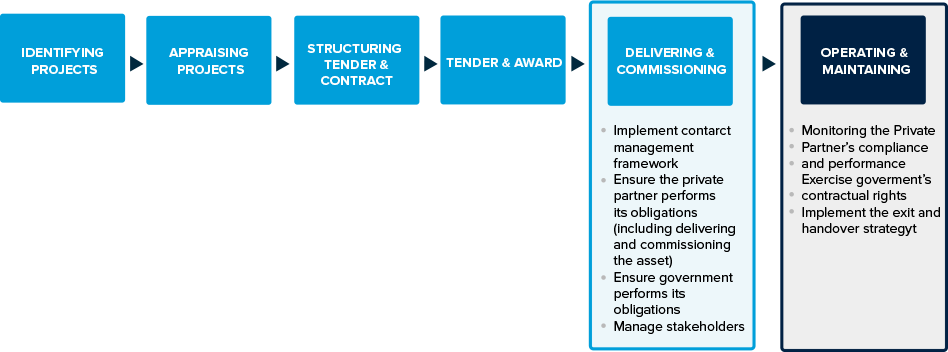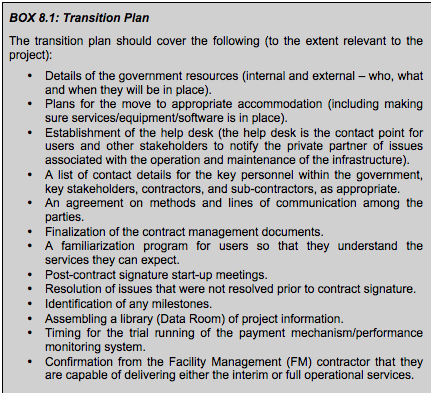In this chapter, the focus will be on the contract management of the Operations Phase. Although the Operations Phase contains different aspects in comparison with the Construction Phase, the mechanism for applying good practice contract management therein does not differ significantly from the Construction Phase. Therefore, the introductory part of chapter 7 must be read in conjunction with this chapter.
This chapter will describe the contract management mechanisms that need to be put in place to monitor the private party’s performance, legal, and financial changes that might happen over the Operations Phase. The Operations Phase in this context is taken to be the contract duration from the time that the asset has been constructed and commissioned, right through to the project exit and hand-over of the asset back to the government.
Therefore, this chapter deals with the contract management activities required by both parties during the Operations Phase. See box 8.1.
BOX 8.1: Learning Objectives
|
After studying this chapter, the reader should understand the following procedures.
|
Where are We in the Process Cycle?
In the previous phase, the private partner delivered and commissioned the different components of the project. The government implemented its contract management framework, ensured that both the private partner and the government performed their obligations, and managed stakeholder interfaces.
In this phase, the private partner delivers services in accordance with the output specification in the PPP contract and maintains the project assets. The government monitors the private partner’s compliance and performance against the contract. The government also exercises its contractual rights in relation to such matters as changes in the project and services, changes in ownership and/or transfer of shares in the private partner, refinancing, and infrastructure renewals. In the lead up to termination or expiry of the contract, the government implements its exit and hand-over strategy.
At the end of this phase, the PPP reaches the end of the PPP process cycle. See figure 8.1.
FIGURE 8.1: Where We are in the Process Cycle

1.1. Transition from the Construction to Operations Phase
Between the end of an asset’s construction and the beginning of its operation, there is a substantial transition period where most, if not all, of the professionals who designed, installed, and verified the initial condition of the asset cease to be involved. A new team of people begins to run the asset, taking on the phase with far greater costs and environmental impact. This shift in personnel presents one of the greatest risks to the parties’ ability to bridge the gap from construction to efficient operations.
Additionally, assets naturally trend toward "performance decay", a phenomenon responsible for as much as 30 percent in efficiency loss in the first four years of operation in buildings such as offices, schools, and hospitals.
Today, many new assets follow a decade old approach to the design and construction process, particularly with regard to the contractual agreements binding the teams and the protocols of communication between team members. Most importantly, the typical roles represented at the table have not changed in a very long time, although assets such as buildings have become far more technologically complex and are delivered in less relative time for ever decreasing fees.
In this model, during the earliest and most critical phases of planning and design, not all members of the ideal team are present. Of particular note, the facility manager is rarely present during design discussions. Yet the person expected to manage operations and maintenance staff and effectively uphold the performance of a facility should clearly have input during the design phase. In addition, the facility manager should play an important role in ensuring that the trade-offs between construction costs and operating and maintenance costs are fully considered (it may be beneficial to spend more up front on higher quality construction, as this may reduce operating and maintenance costs over the long term, or vice versa). However, this person is only consulted much later in the process.
A further weakness in this model is that it is common for design roles to remain segregated and communication kept to a minimum with all parties — with work being pushed to be "done" in order to preserve profit. Everyone involved up until the completion of construction essentially leaves, turning over the facility to an entirely new group of professionals. Even assuming the facility is in top shape upon delivery, the new staff lack the history of why systems and settings were designed the way they were.
Without this knowledge, the operations and facility management staff cannot be expected to achieve the performance set forth in the design. Therefore, the government should ensure that its project plan includes the work to be undertaken to prepare for the transition period after post preferred bidder stage. The plan, referred to as the transition plan, should include dependencies, time scales, and resources. The plan should also be updated regularly. See box 8.2.

The transition plan should link to the communications plan to ensure that the timing is appropriate and that stakeholders have been prepared for the changes. It is essential that the contractor is not delayed by any action, or lack of action, on the part of the government. The PPP contract also sets out processes and time scales for actions by the government. The government needs to have the appropriate staff in place as well as the systems up and running to comply with its obligations. In addition, it is essential to have a full-time, competent, knowledgeable and respected senior staff member on site leading up to and through the transition plan period; this helps ensure a smooth transition.


Add a comment